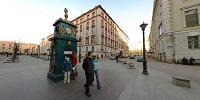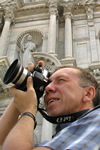
Keeping a Finger on the Pulse of the Atmosphere
Malaya Konyushennaya Ulitsa, Saint-Petersburg, Russia
March 24, 2007 - 16:07 UTC (19:07 local time)
© 2007 Andrew Varlamov, All Rights Reserved.
Some of these stations survived the last 100 (and more!) years intactly, others were restored and modernized.
The oldest (1854) of existing today weather stations is situated at Osterwald embankment of Swiss Neuchatel. You can find details in August issue of magazine "Heimatschutz / Sauvegarde", 2004.
They have different names in different languages: meteorological column in English, colonne météorologique in French, Wettersäule in German. The architectural appearance of weather stations was different too. You can find a growing photographic archive of ancient and new weather stations at www.wettersaeulen-in-europa.de web site.
In the USA weather stations were named "weather kiosks". Weather kiosks were installed by Weather Bureau of Department Agriculture. It is known that weather kiosks were mounted at Washington, D.C. (1909), Peoria, Illinois (1912-1936), Chicago and San Diego, California (1912). To read more look into "Montly Weather Review" magazine Vol. XXXVII, March, 1909, pages 89-91.
In Saint Petersburg a Meteorological Weather Pavilion was erected in 1914. Architect Nikolay Evgenyevich Lansere was the author of the project ordered by the Town Council. Initially a pavilion was placed at the corner of Nevsky Prospekt and Malaya Konyushennaya Ulitsa, opposite to Kazansky Cathedral. In 1997 pavilion was restored in a new place - the central part of Malaya Konyushennaya Ulitsa not far from the Swedish Consulate. Alexey Nikolayevich Lansere, son of Nikolay Lansere, was participant of renovation process.
Now the meteorological pavilion is equipped with one week recording devices - thermograph and barograph.
The more things change, the more they stay the same. Mankind is still interested in Earth's atmosphere. Following the Man weather kiosks become more "intelligent", they are linked up to weather networks which connect numerous weather cameras keeping watch over Earth's atmosphere.
Useful links:
Evgeniy Denisov, Article how meteorology came into Russia from "Kommersant-Dengi" magazine №47(603), November 27, 2006 (in Russian)
Monthly reports of 17 automatic stations from Saint-Petersburg about level of air pollution (since January 2004) (in Russian, too)
Lat: 59° 56' 15.9" N
Long: 30° 19' 32.16" E
Elevation: 1.8
Precision is: High. Pinpoints the exact spot.
Software: PTGui 6.0.3 by New House Internet Services B.V. (dated by 10 october 2006), MinGW version of PanoTools library 2.8.0 (dated by November 24, 2005) from Jim Watters' PanoTools site, Pano2QTVR version 1.5.2 pro flash by Thomas Rausher).
Cell Phone Software: Compass 4.1 for J2ME by Dana Peters (to calculate Sun and Moon position in the sky), DoF Calculator by Paul Mutton
Их называли по-разному на разных языках: „meteorological column” - по-английски, „colonne météorologique” - по-французски, „Wettersäule” - по-немецки. Внешний вид метеорологических станций тоже был разнообразным. Увидеть, как они выглядели раньше и как выглядят сейчас, можно на сайте интернета www.wettersaeulen-in-europa.de.
В США такие уличные метеорологические станции получили название "киосков погоды". За их установку отвечало Бюро погоды при Министерстве сельского хозяйства. Известно о существовании таких киосков в Вашингтоне (1909), Пеории (штат Иллинойс) (1912-1936), Чикаго и Сан-Диего (штат Калифорния) (1912). Подробности - в мартовском номере журнале "Montly Weather Review" за 1909 год.
В Санкт-Петербурге Метеорологический павильон погоды был возведен в 1914 году по проекту архитектора Николая Евгеньевича Лансере, выполненому по заказу Городской Управы. Первоначально павильон располагался там, где Малая Конюшенная улица выходит на Невский проспект - почти напротив Казанского собора.
В 1997 году павильон был восстановлен в центральной части Малой Конюшенной улицы, ближе к Шведскому консульству. В восстановлении участвовал сын Н.Е.Лансере - Алексей Николаевич. Сегодня в Метеорологическом павильоне установлены термограф и барограф с регистрационными лентами, расчитанными на неделю записей.
Времена меняются, но по-прежнему человечество интересует атмосфера Земли. Вслед за человеком киоски погоды становятся более "умными", они интегрируются в сети наблюдения за погодой, имеющие доступ к видеокамерам, следящим за атмосферой Земли.
Полезные ссылки:
Статья Евгения Денисова "Хлябь всему голова" из журнала "Коммерсант - Деньги" №47(603) от 27.11.2006 г. (об истории метеорологии в России)
Ежемесячные отчеты 17 автоматических станций Санкт-Петербурга о загрязнении атмосферного воздуха (ведутся с января 2004)
Meteorological Pavilion was my plan A. My plan B was to shoot stone near place of mortal crash (1913) of Russian aviator Leo Matsievich at Komendantsky Airfield. In Tuesday evening I shot panorama for plan B, in Saturday - for plan A.
First one was blurry (I set focal distance less than hyperfocal distance of Fish-eye lens) and boring. In 1970s Komendantsky Airfield was built by appartment houses, its streets were named in honor of russian aircraft designers - Kotelnikov, Korolyev, Polikarpov, Sikiorski, Ilyushin, but this panorama was more suitable for 'Garden' theme.
Second panorama was more natural because place for shooting was crossroad. As You see the crossroad is fenced by Gaudi-styled flowerpots to prohibit car movement. It is here where the shortest route from metro station 'Nevsky Prospekt' to the State Hermitage Museum runs.
Weather was sunny with little clouds, air temperature was equal 10 degrees of Celsius, but cold wind didnt permit to relax. At least after 3 trial series I took 6 photographs around, 1 for zenith (decreasing exposure by 1 step), 1 shot for nadir without tripod. Camera setting were the next: White Balance = Shade, Sensitivity = ISO 400, Aperture f/5.6, exposure time = 1/180 s, focal length = 10 mm, focal distance = hyperfocal (90 cm) (because distance wheel of Pentax DA Fish-Eye lens has got only 2 last labels 0.5m and infinity, distance index was set between these labels).


 Tap or click the zoom icon in the bottom right corner of the picture to switch between in-page and fullscreen view
Tap or click the zoom icon in the bottom right corner of the picture to switch between in-page and fullscreen view